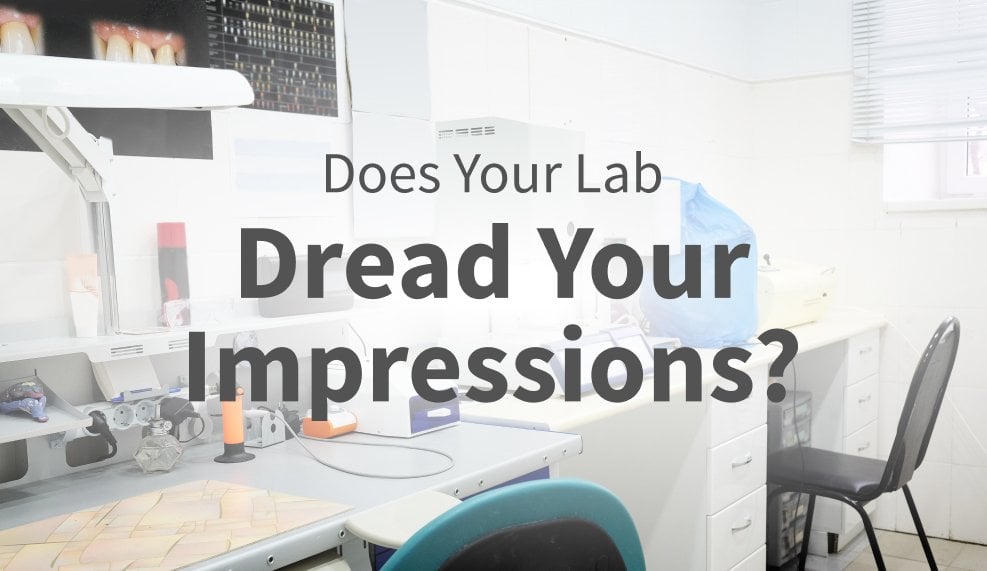By Dr. Mark Pettit, DDS
Call me paranoid, but I don’t think I’m alone in having wondered what the dental lab I use thinks of my dentistry. Sure, dental labs deal with things like poor retentive preps, illegible finish lines (margins), pulls in the impression, different viscosity impression materials that aren’t properly blended, insufficient reduction, and inaccurate bites on a daily basis. The real question is, does the lab dread, or love seeing your impressions come through their door?

A little background: I have a favorite local lab. I’ve tried the big labs in the bigger cities, and they’ve done some great work for me, but I consistently love the results from the smaller lab in town. They pick up my cases at my office, and oftentimes send them back early. They’ll help me with custom shading if needed, and even rush a case when I’ve overextended myself.
A few years ago, I had a tough case to send to the lab. It had a deep subgingival finish line on a tooth that fractured just a little too deep. It wasn’t quite enough to resort to crown lengthening with a periodontist, but it was close. I decided to handle it with traditional crown and bridge dentistry. While the impression looked good, I knew the lab may have trouble finding the finish line in the impression. I’m a big believer in owning my own work, so on my day off, I drove to the lab with my loupes, a blade, and a red pencil to trim the die myself to avoid having to write out complicated instructions.
It probably took me 20 minutes to trim the die and I felt confident about the final result. However, I had some time to kill, so I offered to help them trim the dies from a few other cases they had on their hands. These weren’t my impressions and I was quickly humbled by how difficult I found it to locate the finish line on an unfamiliar impression. That experience made me realize we don’t give our labs enough credit for what they do to transform our sometimes mediocre work into high quality crowns.
So, I decided to come up with a few tips for other dentists on how to make your lab rave about you, versus dread your cases.
Shortcuts Won’t Cut Your Time
As a teenager, I worked in an incredible little bike shop in Silicon Valley. My boss—a former Olympian—exhibited exceptional patience in teaching a bunch of teenage kids how to service bikes and help customers. As a teenager, naturally, we always looked for shortcuts to do our work faster. As a result, it was there I learned one of my greatest life lessons: The long way is actually the fastest way.
There really are no shortcuts. I’ve learned that trying to rush something usually results in poor quality or having to start over. Taking shortcuts at the bike shop always led to longer repair times because I had to do it over until it was right. The same principle holds true for dentistry. Sure, we can be more efficient with some things, but more often, there are certain steps that must be followed to get quality results. Or, you’ll find yourself starting over and wasting precious time.
Don’t Fall Victim to Ill-Advised Trends
Many years ago, I read a series of articles promoting the “60 second crown prep.” Some dentists my age may remember this trend. While it presented ways dentists could cut a few corners in the name of time management, I ended up asking myself, Would I want a 60-second crown prep performed in my mouth? My answer? Noooo thank you!
- Take the time to place your finish line where you know it needs to be.
- Break the contact, protect the adjacent teeth, and create a finish line that can be seen.
- Place that buildup if needed for proper retention.
- Reduce the prep enough that the lab can give you some anatomy but do not over reduce the tooth into a nub.
In the end, following these steps meticulously pays off in time and quality.
Get in Control (of Bleeding)
Before packing cord, taking an impression, or fabricating a provisional, remember these words, “Get in control.” Dr. Dan Fischer, founder of Ultradent Products, Inc., has taught this for years. It is absolutely imperative to get tissue bleeding and other fluids under control before moving on to any procedure in dentistry. If not, your impressions and final product will be lacklustre, everytime.
To do this, I love using one of Ultadent’s four hemostatic solutions. My favorite is Astringedent™ X hemostatic, which is made up of an iron solution that stops bleeding in seconds. A coagulum forms when used correctly. It works like a charm.

Astringedent™ X hemostatic
However, the operative words are “when used correctly,” when it comes to getting results. Don’t just apply the hemostatic. Per the product instructions, the solution requires scrubbing it with adequate pressure into the sulcus. The product needs to reach the capillaries and form temporary cork-like plugs to do its job. I like using Ultradent’s specially designed yellow Metal Dento-Infusor™ tip for making sure the Astrigedent X hemostatic solution really gets into the patient’s tissues and sulcus. Test your work with a vigorous spray of water to see if you need to continue scrubbing the solution into the tissues. If they still bleed, scrub and retest until the bleeding is completely under control. This is so critical before moving on to retraction.
This post continues in Part II, available November 16, 2021
About the Author
Dr. Mark Pettit

Dr. Pettit graduated from Creighton University’s dental school in 1994. He currently runs and owns a small private practice in Salt Lake City where he works with his wife, who manages the office. Together, they’ve raised three sons, who are all attending college.
Having grown up in Northern California, Dr. Pettit now calls Utah home. He loves road biking in the warmer months, and for many years, worked part-time every ski season at one of Utah’s world-famous resorts for a hobby as a side gig. In addition to practicing dentistry, Dr. Pettit also works as a consultant and researcher at Ultradent Products, Inc., in their clinical affairs department.







